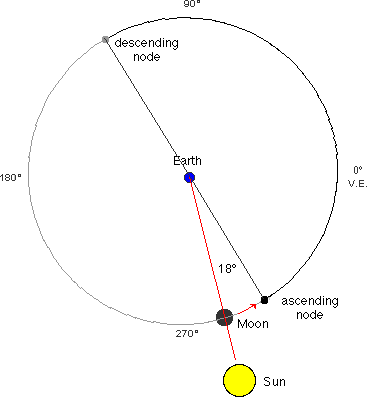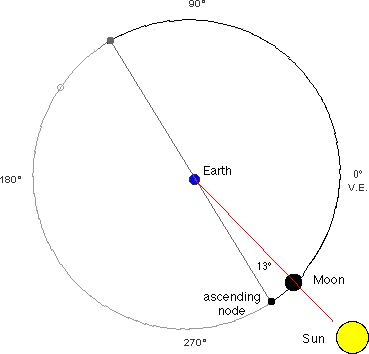| Start | Saros | Saros-Inex | total eclipses | annular eclipses |
The 5 solar eclipses of 1935JD 2427807.733
(images created by my "Planets Applet")
|
|
|||||
|
|
Greatest Eclipse |
|
|
mag. |
|
|
1935 Feb 03 1935 Jun 30 1935 Jul 30 1935 Dec 25 |
16:16 19:59 09:16 17:59 |
P P P A |
149 116 154 121 |
0.738 0.337 |
62.5N 115.5W 65.2N 39.2E 62.9S 6.0W 83.5S 9.3E |
The solar eclipses of 1935 Jan 05, 05:35 UT
JD 2427807.733
|
The eclipse of 1935 Jan 05 is partial and very small, the maximum magnitude only 0.001. |

The solar eclipses of 1935 Feb 03, 16:16 UT The eclipse is partial, magnitude 0.728, and 29.45 days
(about one synodic month) later than the eclipse of Jan 05.
The solar eclipses of 1935 Jun 30, 19:59 UT The magnitude of this partial eclipse is 0.337. Since Jan
05, the ascending node of the Moon hase moved from
302.02° to 292.67° in ecliptic longitude
(retrograde).
As seen from the Earth, the synodic period T of the Sun
(T1=365,24 d) and the ascending node of the Moon (the
nodical regression cycle takes 18.61 years, T2=18.61*365.24
d) can be computed from
This period (346.6 days) is called eclipse year
(or draconitic year), 18.6 days short of a solar year,
and equal to the time required by the Sun to complete one
revolution with respect to the same lunar node. There are
two eclipse seasons of 173.3 days each year.
JD 2427837.178
JD 2428014.333
T = 346.6 d

© 2005 Juergen Giesen
![]()